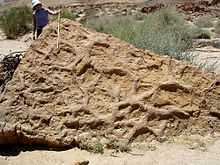Burrow


A burrow is a hole or tunnel excavated into the ground by an animal to create a space suitable for habitation, temporary refuge, or as a byproduct of locomotion. Burrows provide a form of shelter against predation and exposure to the elements, so the burrowing way of life is quite popular among the animals. Burrows are also commonly preserved in the fossil record as a type of trace fossil.
Examples
Examples of burrowing animals include a number of mammals, amphibians, fish (dragonet and lungfish[1]), reptiles, and birds (including small dinosaurs[2]), as well as numerous invertebrates including insects, spiders, sea urchins, crustaceans, clams and worms.
A wide variety of animals construct or use burrows in many different types of substrate. Mammals are perhaps most well known for burrowing, especially Insectivora like the voracious mole, and rodents like the prolific gopher and groundhog. The rabbit, a member of the family Lagomorpha, is a well-known burrower. There are estimations that a single groundhog burrow occupies a full cubic metre, displacing 320 kilograms of dirt. Even Carnivora like the meerkat, and marsupials, are burrowers. The largest burrowing animal is probably the polar bear when it makes its maternity den in snow or earth.
Burrows by birds are usually made in soft soils; some penguins and other pelagic seabirds are noted for such burrows. The Magellanic Penguin is an example of such a burrow constructor, making burrows along coastal Patagonian regions of Chile and Argentina.[3] Other burrowing birds are puffins, kingfishers, and bee-eaters.
Burrows can be constructed into a wide variety of substrates. Kangaroo mice construct burrows in fine sand. Scabies mites construct their burrows in the skin of the infested animal or human. Termites construct burrows in wood. Some sea urchins and clams can burrow into rock. Burrows can also range in complexity from a simple tube a few centimetres long to a complex network of interconnecting tunnels and chambers hundreds or thousands of metres in total length, such as a well-developed rabbit warren.
See also
| Wikimedia Commons has media related to Burrows. |
- Maternity den
- Sett- a network of badger tunnels.
References
- ↑ Dubiel, Russel; Blodgett, Robert H; Bown, Thomas M (May 1987). "Lungfish Burrows in the Upper Triassic Chinle and Dolores Formations , Colorado Plateau". Journal of Sedimentary Petrology 57: 512–521.
- ↑ Varricchio, David J.; Martin, Anthony J.; and Katsura, Yoshihiro (2007). "First trace and body fossil evidence of a burrowing, denning dinosaur". Proceedings of the Royal Society B: Biological Sciences 274 (1616): 1361–1368. doi:10.1098/rspb.2006.0443. PMC 2176205. PMID 17374596. Retrieved 2007-03-22.
- ↑ C. Michael Hogan, (2008) Magellanic penguin, Globaltwitcher.com, ed. Nicklas Stromberg
